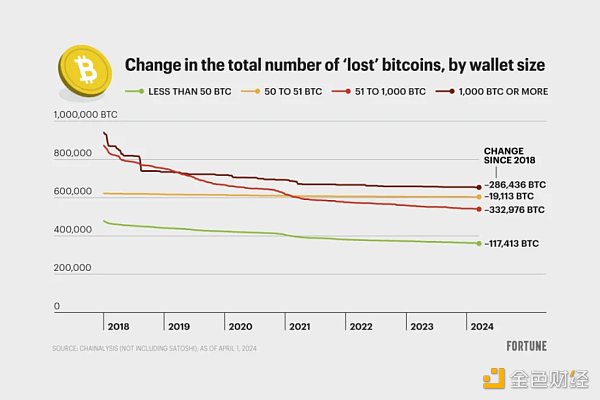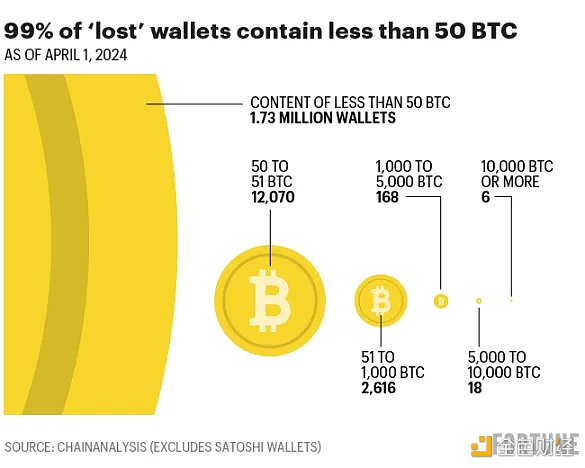Author: Jeff John Roberts, Fortune Magazine; Translated by: Luffy, Foresight News
On April 15, a Bitcoin wallet that had been dormant for 14 years came to life. The wallet's owner sent 50 bitcoins to Coinbase, making more than $3 million in profits from these once-worthless bitcoins. Such transactions are uncommon, but they are not unique. Early Bitcoin wallets come to life almost every week, raising the question of how many of the presumed lost bitcoins can be put back into circulation. A new investigation by Fortune and Chainalysis provides some insights.

Chart shows the change in the number of lost bitcoins since 2018
As shown in the above figure, hundreds of thousands of "lost" bitcoins (which Chainalysis defines as bitcoins that have not moved since 2014) have been recirculated in the past few years. The figure shows the net change in the total amount of bitcoins in four wallets of different sizes, including wallets holding less than 50 bitcoins and wallets holding 1,000 bitcoins or more. Among them, the "less than 50" category accounts for the vast majority of old Bitcoin wallets, as shown in the figure below.

Charts showing a breakdown of lost bitcoin wallets
Both charts show a disproportionate number of old wallets containing 50 bitcoins. This reflects the fact that in bitcoin's early days, the block reward was 50. (Since then, a series of "halving" events have reduced the reward to 25, 12.5, 6.25, and just last week, to 3.25 bitcoins).
Now that less than 10% of the number of bitcoins mined each day were there in the earliest days, early wallets, many of which contain vast fortunes, are likely to attract greater interest.
$121 billion
Those with only a casual interest in cryptocurrencies might be surprised to learn that there are about 1.75 million Bitcoin wallets that have been completely dormant for a decade or more, many of which contain large amounts of funds. As of mid-March, these wallets (excluding about 30,000 wallets associated with Bitcoin creator Satoshi Nakamoto) contained 1,798,681 Bitcoins, which today are worth about $121 billion.
The 1.8 million "lost" Bitcoins represent about 8.5% of the total supply of 21 million Bitcoins (93% of which have been mined). In most cases, it's impossible to know exactly where a particular wallet has gone, but it's safe to say that many of the Bitcoins in these wallets are indeed lost forever. In Bitcoin's early days, the cryptocurrency was worth almost nothing, and it wasn't until 2011 that the price of Bitcoin broke the $1 mark. So many people who received Bitcoin may have forgotten about it altogether, or didn’t bother to save the private key needed to open the wallet. Prior to 2012, companies like Coinbase that held private keys for users didn’t exist, so lost keys were especially common.
But not all idle wallets are lost or abandoned. Bitcoin is known for its large population of “HODLers” who vow to never sell their stash (or at least to hold onto it for the long term). It’s these people (who have “diamond hands,” in crypto parlance) who manage the handful of wallets that have been active since 2018.
So why are they selling? Chainalysis’ analysis of newly active wallets found a statistically significant correlation between changes in Bitcoin’s price and wallet activity in a given week. Most of the time, however, the increase in wallet activity doesn’t seem to be linked to obvious external events.
Overall, old wallets appear to be activated at a predictable rate. For example, during the week of March 25, a typical pattern emerged, with 172 long-dormant wallets becoming active, including 169 wallets with less than 50 bitcoins and one wallet with more than 1,000 bitcoins. Many Bitcoin holders have more than one wallet, especially those who had wallets before 2014, so the number of wallets activated that week is likely much lower than 172.
Variable: Satoshi’s 1.1 million bitcoin
Chainalysis’s investigative data suggests that old wallets will continue to be awakened at a steady but slow pace until the number of lost bitcoins has roughly stabilized: around 1.5 million.
However, we can imagine that the pace of wallet awakenings will accelerate in the future. That is, this may happen when pre-2014 HODLers age and bequeath their long-held bitcoins to their children, who in turn sell those bitcoins. However, such an event is still decades away, as most early Bitcoin holders are only in their 20s or 30s.
Finally, the above number of "lost" Bitcoins does not include wallets controlled by Satoshi Nakamoto, who owns about 1.1 million Bitcoins, according to Chainalysis estimates. A recent Fortune report on Satoshi Nakamoto's wealth (worth about $75 billion) found that most long-term cryptocurrency watchers believe that the Bitcoin creator has long since become a myth and they will most likely never touch their wallets.
If this is true, the total number of lost Bitcoins currently is about 2.9 million, accounting for nearly 14% of the total supply. In the long run, the best outcome is that these Bitcoins become lost treasures that will never be found.
 XingChi
XingChi







